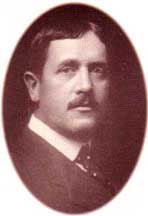Williams Lansing

1860-1920
A member of one of Buffalo's oldest families, he was the son of Bleeker B. and Sophia E. Williams Lansing, born 1 October, 1860 at the home of his grandfather, E. P. Williams, on Court Street on the future site of Shea's Theater.
After graduating from Buffalo State Normal School, he went to Colorado and spent several years on western ranches.
Architecture career
1886 Employed by Green & Wicks 1889 Solo practice C. 1892 Lansing & Beierl. Max G. Beierl (rhymes with spiral), another Green & Wicks draftsman. Their office was at 371 Pearl St. 1910 Lansing Bley & Lyman. (See also Duane Lyman). 1919 Lansing and Oakley, with A. J. Ort as associate Lansing designed the Hersee Block in Main Street, H. O. Mills, Canisius College, Holy Family RC Church, the homes of Harry T. Ramsdell, Bronson Rumsey, John W. Bush, Myron P. Bush, Edward S. Warren, and Mrs. David Gunsberg. He was supervising architect of the Pan-American buildings.
At the time of his death, he was completing the sales rooms of the Lafayette-Buffalo company, the subject of constructing motor car sales rooms and service stations.
Personal life
Lansing's own home at 29 Oakland Place was designed in 1898, [Max G. Beierl's House: 104 Robie]He was a member of Trinity Episcopal Church
As an ardent supporter of aquatic and all outdoor sports, he was a founder of the Buffalo Canoe Club and its first Commodore.
One of his last public utterances was a plea for the preservation of elms on lower Delaware Avenue.
Death
His death came quite unexpectedly, Mr. Lansing having been at his office a usual the day before. He suffered from a stroke during dinner at his home at 200 Bryant Street, from which he never regained consciousness. He died one day short of his sixtieth birthday.He was survived by his wife, Mrs. Mary Vought Lansing, his daughter, Mrs. Arnold C. Saunder, Jr., and two brothers, Gerrit B. and Stuart Lansing.
At the time of his death, his firm was known as Lansing and Oakley, with A. J. Ort as associate. Both his partners were bearers. He was buried in Forest Lawn Cemetery, Buffalo, New York - Lot #35, Section AA, an area befitting his stature in life, the family plot located next to the grave of Williams G. Fargo of Wells-Fargo fame.
Williams Lansing was born on October 1st, 1860 to one of Buffalo’s oldest and most prominent families. After graduating from Buffalo State Normal School he went to Colorado and spent several years on western ranches before returning to Buffalo to work in the architectural office of Green and Wicks. Lansing worked briefly as an independent architect before partnering with fellow Green and Wicks draftsman Max G. Beierl around 1892.
He served as supervising architect for the Buffalo Pan-American Exposition in 1901 before joining with Bley and Lyman in 1910. After he left the firm of Lansing, Bley and Lyman he joined with another architect of the name Oakley in 1919. Among his most prominent works were the Connecticut Street Armory (1898-1900, NR 1995) with State Architect Isaac Perry, the C. W. Miller Livery Stable (with Beierl in 1892-94, NR 2007) and the homes of several prominent Buffalo businessmen.
Lansing died after suffering a stroke on September 30th, 1920 at his home at 200 Bryant Street. He was buried at Forest Lawn Cemetery.
- Jennifer Walkowski, History of Buffalo Seminary
Chester Oakley announces that he has dissolved the firm of Lansing & Oakley, and will practice architecture with Albert J. Schallmo, under the title of Oakley & Schallmo, architects with offices at 70 West Chippewa Street.
- American Architect and Architecture, Volume 120, p. 68 (online May 2013)
Online buildings, by date:
- Lafayette Presbyterian Church, 590 Elmwood Ave. - 1894, Lansing & Beierl
- C. W. Miller Livery Stable 1895, Lansing & Beierl
- Sibley & Holmwood Candy Company 1896, Lansing & Beierl
- Lansing House, 29 Oakland Place 1898, Lansing & Beierl
- Truscott House, 33 Oakland Place 1898, Lansing & Beierl
- Hotchkiss House, 37 Oakland Place 1897-98, Lansing & Beierl
- Hewitt House, 619 Lafayette Ave. - 1898, Lansing & Beierl
- Our Lady of Perpetual Help - 1897-1900, Lansing & Beierl
- Connecticut Street Armory - 1898-1900, Lansing & Beierl
- Photo - Mann (John A.) House, 28 Oakland Place 1901, Lansing & Beierl
- Bush (John W.) House, 6 Lincoln Pkwy 1903, Lansing & Beierl
- Bush (Myron P.) House, 14 Lincoln Pkwy. 1902, Lansing & Beierl
- Hotchkiss House, 20 Lincoln Pkwy. 1904 Lansing & Beierl
- Philip Smith / College Club House, 264 Summer St. - 1904, Lansing & Beierl
- Holy Trinity Lutheran Church, 1080 Main St. - 1905, Lansing & Beierl
- Holy Family Church - 1908, Lansing & Beierl
- William C. Maltby House, 137 Depew Avenue - C.1915, Max G. Beierl
- Photo - Lyman M. Bass House, 129 Oakland Place - 1907, Lansing & Beierl
- Central Presbyterian Church, 15 Jewett Ave. - 1910, Lansing & Beierl
- Ramsdell House - 1910, Lansing
- St. Francis Xavier RC Church, 149 East St. - 1911-1913, Lansing & Beierl (Lyman?)
- David Gunsberg House/ Buffalo State College President's House, 152 Lincoln Pkwy. (Lansing Bley & Lyman)
- Photo - 327 Buffalo Avenue, Niagara Falls, NY (Built for W. Acheson Smith, the VP of Acheson Graphite Co.) - 1919, Lansing Bley & Lyman
- 109 Chapin Pkwy - ?. Lansing & Beierl
- Photo: Annunciation RC Church Rectory, 257 Lafayette Ave.- 1921-22, Lansing & Oakley
Sources:
- Martin Wachadlo, Consultant
- Buffalo Express, October 1, 1920
- Buffalo Times, October 1, 1920
- Warren R. Baltes, The Story of the 74th Regimental Armory in Buffalo, New York